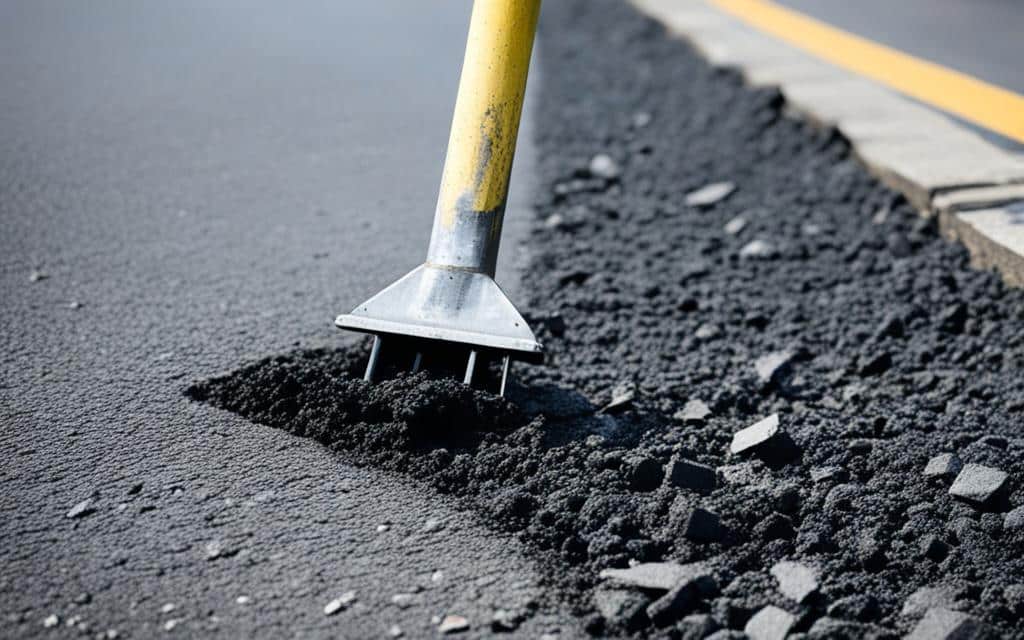Potholes are a big problem on our roads. They can hurt our cars and make driving risky. It’s key to fix potholes fast and right. But there are many ways to do it, each with its ups and downs.
We’ll dive into the good and bad of fixing potholes in different ways. We’ll cover common methods like throw-and-go, throw-and-roll, semi-permanent, and spray injection. We’ll also talk about the costs, including work, materials, and tools. And, we’ll see how using an asphalt hot box and recycler can save money and make work easier. For all your pothole repair needs in San Mateo, CA, and nearby, reach out to HT Paving.
If you’re into keeping roads in good shape or work for a city, knowing about pothole repair is key. Let’s find out how to fix potholes right, without any issues.
Key Takeaways:
- There are various methods of pothole repair, each with its own pros and cons.
- The commonly used techniques include throw-and-go, throw-and-roll, semi-permanent, and spray injection.
- The costs associated with pothole repair include labor, materials, and equipment.
- Investing in an asphalt hot box and recycler can help reduce costs and increase efficiency.
- Understanding the pros and cons of pothole repair techniques is vital for road maintenance and keeping transportation infrastructure safe.
- Contact HT Paving for all your pothole repair needs in San Mateo, CA and surrounding areas.
Pros and Cons of Different Pothole Repair Techniques
There are many ways to fix potholes, each with its advantages and disadvantages. Knowing these can help you choose the best method for your needs. This makes your decision well-informed.
The Throw-and-Go Technique
The throw-and-go method is very common. It involves filling the pothole with asphalt and pressing it down. While it’s fast and cheap, the fix might not last long because the patch can break down. This method is great for quick patches but not for long-term fixes.
The Throw-and-Roll Technique
The throw-and-roll method has more steps. First, workers add asphalt, then a heavy truck drives over to firmly press it. This makes a stronger patch that holds up better against cars. It’s seen as better than throw-and-go for longer fixes. Contact HT Paving for all your pothole repair needs in San Mateo, CA and surrounding areas.
The Semi-Permanent Method
The semi-permanent way is often the top choice. It begins with clearing debris from the pothole. Then, workers add asphalt and use a machine to compact it tightly. This creates a patch that’s very strong, lasting a long time. It’s known for being a durable fix.
The Spray Injection Method
Spray injection works well for cracks across the road. A special machine puts a tough mix into the crack. This totally fills the gap, creating a smooth path. Yet, it might take a while before cars can drive over it again. It offers a high-quality fix, but with some waiting time.
Every pothole repair method has its ups and downs. The right choice depends on the pothole’s size, traffic, and budget. Always consult experts for the best road fix.
Challenges in Pothole Repair and the Benefits of Hot Boxes
Fixing potholes is tough. The cooling material slows work and poses health risks. Workers tossing it from trucks adds to the problem.
Low-quality asphalt is another issue. It doesn’t last, leading to frequent repairs and higher costs. Hot boxes help overcome these challenges.
Hot Boxes keep asphalt warm for better work. They use VIP technology to keep the temperature right. You can find dump boxes to trailer options for any job.
Hot Boxes improve repairs. They reduce waste and speed up work. This makes projects finish faster and work more safely.
Contact HT Paving for all your pothole repair needs in San Mateo, CA and surrounding areas.
FAQ
What are the pros and cons of pothole repair?
Repairing potholes keeps roads safe and saves money. But it’s costly and time-consuming. You need the right tools, materials, and workers for a good job.
What are the different techniques used for pothole repair?
There are four main ways to fix potholes: throw-and-go, throw-and-roll, semi-permanent, and spray injection. Each has its own cost, time, and quality benefits.
How does the throw-and-go method work?
The throw-and-go method is quick and cheap. You fill the hole with asphalt and press it down lightly. But, it might not last long.
What is the throw-and-roll method?
Throw-and-roll fills the hole with asphalt and presses it down with a truck. It makes a stronger patch than throw-and-go, but takes more effort and time.
What is the semi-permanent method?
The semi-permanent method is best for lasting results. You clean the hole, layer asphalt, and press it well. It lasts long but takes more time and effort.
How does the spray injection method work?
This method is great for wide cracks. It uses special gear to push asphalt into the crack. It works well, but the road might need to stay closed longer.
What are the challenges in pothole repair?
Repairing potholes is hard. Materials cool down fast, which is bad. Workers can hurt their backs shoveling from high truck beds. Bad quality asphalt can make patches break down quickly.
How can hot boxes solve these challenges?
Hot boxes keep asphalt warm and easy to use. They solve many pothole repair challenges by not wasting material, making work quicker, and keeping workers safe.
What benefits does a hot box offer?
Hot boxes have special technology. They come in many types and offer things like less waste, faster work, and better worker safety. Contact HT Paving for all your pothole repair needs in San Mateo, CA and surrounding areas.






